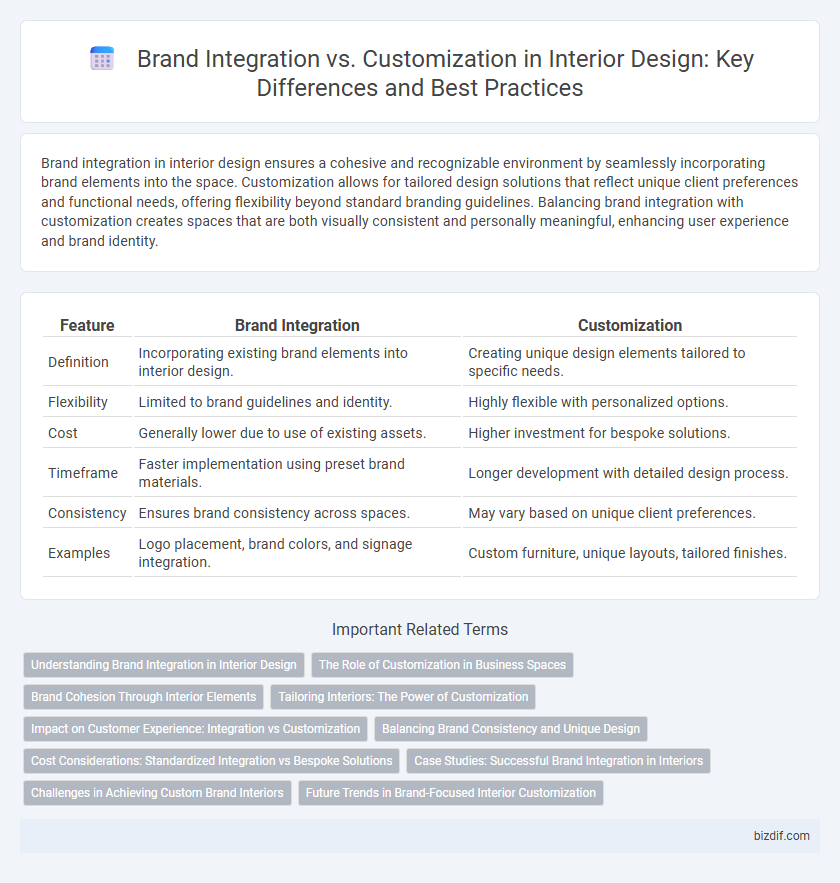Brand integration in interior design ensures a cohesive and recognizable environment by seamlessly incorporating brand elements into the space. Customization allows for tailored design solutions that reflect unique client preferences and functional needs, offering flexibility beyond standard branding guidelines. Balancing brand integration with customization creates spaces that are both visually consistent and personally meaningful, enhancing user experience and brand identity.
Table of Comparison
| Feature | Brand Integration | Customization |
|---|---|---|
| Definition | Incorporating existing brand elements into interior design. | Creating unique design elements tailored to specific needs. |
| Flexibility | Limited to brand guidelines and identity. | Highly flexible with personalized options. |
| Cost | Generally lower due to use of existing assets. | Higher investment for bespoke solutions. |
| Timeframe | Faster implementation using preset brand materials. | Longer development with detailed design process. |
| Consistency | Ensures brand consistency across spaces. | May vary based on unique client preferences. |
| Examples | Logo placement, brand colors, and signage integration. | Custom furniture, unique layouts, tailored finishes. |
Understanding Brand Integration in Interior Design
Brand integration in interior design involves seamlessly incorporating a company's visual identity, such as logos, color schemes, and design motifs, into the physical space to create a cohesive and immersive brand experience. This strategy enhances customer recognition and emotional connection by aligning the environment with brand values and messaging throughout every element, from furniture to lighting. Effective brand integration requires collaboration between designers and brand strategists to ensure authenticity and maintain functional aesthetics.
The Role of Customization in Business Spaces
Customization in business spaces enhances brand identity by tailoring interior design elements to reflect the company's values and culture, creating a unique and memorable environment for clients and employees alike. Unlike generic brand integration, customization allows for flexible spatial arrangements, personalized color schemes, and bespoke furnishings that improve functionality and promote productivity. This strategic approach ensures that every detail in the workspace supports the brand narrative while meeting specific operational requirements.
Brand Cohesion Through Interior Elements
Brand integration in interior design ensures seamless brand cohesion by embedding logos, color schemes, and thematic motifs directly into architectural elements and furnishings. Customization, on the other hand, tailors interior features to reflect brand identity through unique finishes, materials, and layout adaptations that resonate with the target audience. Both approaches reinforce brand recognition and create immersive environments by consistently aligning visual and spatial elements with the brand's core values.
Tailoring Interiors: The Power of Customization
Tailoring interiors through customization allows for unique expression and functionality that brand integration alone cannot achieve. Customization adapts design elements like furniture, color schemes, and spatial layouts to reflect personal taste and lifestyle needs, enhancing comfort and aesthetic appeal. This personalized approach results in spaces that are not only visually distinctive but also optimized for individual use and satisfaction.
Impact on Customer Experience: Integration vs Customization
Brand integration in interior design creates a cohesive environment that reinforces brand identity and fosters customer trust through consistent visual and sensory elements. Customization enhances customer experience by tailoring spaces to individual preferences, increasing comfort and personal connection to the environment. Combining both strategies balances brand consistency with unique user needs, driving deeper engagement and satisfaction.
Balancing Brand Consistency and Unique Design
Balancing brand consistency and unique design is crucial in interior design, where brand integration ensures a cohesive identity through color schemes, logos, and signature elements that reinforce brand recognition. Customization allows for tailoring spaces to local culture, client preferences, and functionality, enhancing user experience while maintaining core brand values. Effective interior design harmonizes these aspects by blending standardized branding with personalized touches, achieving a distinctive environment that supports brand loyalty and individual expression.
Cost Considerations: Standardized Integration vs Bespoke Solutions
Brand integration in interior design leverages standardized elements to reduce costs through bulk purchasing and streamlined processes, ensuring consistency across multiple projects. Customization demands higher investment due to unique materials, tailored designs, and extended labor hours, increasing overall project expenses. Evaluating cost considerations is essential when choosing between brand integration's affordability and the exclusivity offered by bespoke solutions.
Case Studies: Successful Brand Integration in Interiors
Case studies reveal that successful brand integration in interiors enhances customer experience by embedding brand identity into spatial elements such as color schemes, materials, and signage. For example, Starbucks incorporates its signature green palette and natural textures to create a cohesive brand environment that resonates globally. This strategic alignment between design and brand values drives customer loyalty and strengthens market presence.
Challenges in Achieving Custom Brand Interiors
Achieving custom brand interiors presents challenges such as maintaining brand consistency while allowing for unique design elements that reflect local culture and client preferences. Balancing scalable brand standards with bespoke materials and furnishings requires extensive collaboration between designers and brand stakeholders. Technical constraints, budget limitations, and supply chain complexities further complicate the integration of personalized aesthetics in branded spaces.
Future Trends in Brand-Focused Interior Customization
Future trends in brand-focused interior customization emphasize seamless integration of brand identity through smart materials and adaptive design technologies, enhancing experiential spaces. The rise of AI-driven personalization allows brands to tailor environments dynamically, reflecting real-time consumer preferences and behaviors. Sustainable and modular elements will dominate, enabling flexible brand experiences that evolve with shifting market demands and identity narratives.
Brand integration vs Customization Infographic

 bizdif.com
bizdif.com